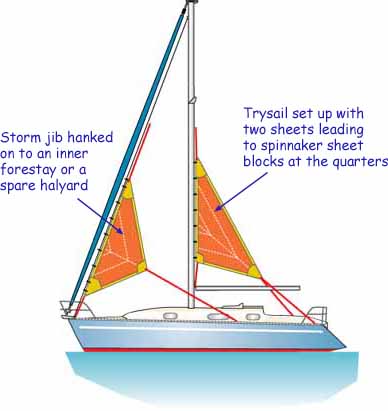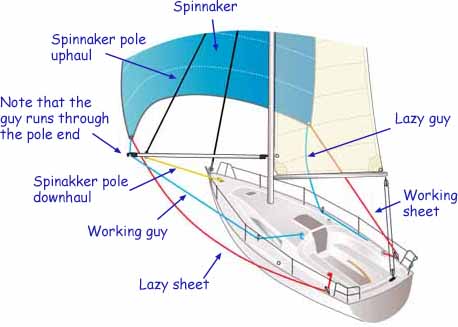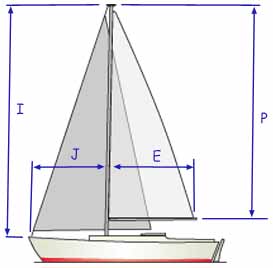Laminate Sails & Molded Sails for Top Performance
Although having become cheaper in recent years, the cost of laminate sails remains higher than that of woven sails of similar strength and size. Nevertheless, their improved robustness and durability means that they are seen with increasing frequency on performance cruising boats.
The main attribute of laminates is their ability to retain their shape, which of course makes them fast - particularly to windward.
In fact they'll delaminate and generally fall apart before losing their shape. This is exactly opposite to the way in which woven sails deteriorate, which stretch and lose their shape long before their construction becomes an issue.
You can probably expect three or four years of good service from laminates if you're a cruising sailor, but many competitive racing sailors budget on having to replace them every season. Ouch!
Construction of Laminate Sails
Laminate sail fabric is built up of layers of film, scrim and taffeta glued together under high temperature and pressure to form a light, strong composite sail fabric.
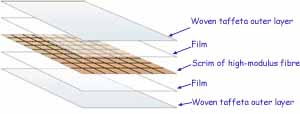 Layered construction of laminate sails
Layered construction of laminate sailsThe film is a sheet of isotropic plastic, most often a Mylar extrusion, which has very low stretch characteristics in all directions, including the bias.
The scrim is a grid of large, unwoven, straight fibres which may be polyester, one of the HMPE varieties, or even more exotic fibres such as carbon. Scrims have very little stretch in the direction of the fibres, and are often bonded with other scrims of different orientation.
Taffeta is a woven fabric, most often polyester, that makes up the outside surfaces of the laminate, and is there to provide durability, UV and chafe resistance to the sail.
Laminates are lighter than woven sails and have a higher modulus.
As most of the scrim is usually orientated on the warp, the panels can be cut in long, narrow triangular shapes ideally suited to accommodate the stress patterns in a radially cut sail.
Molded Sails
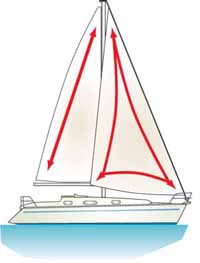 Direction of forces in a triangular sail secure along one edge and one corner
Direction of forces in a triangular sail secure along one edge and one cornerSails built up in a series of bonded-together flat panels can only ever approximate - albeit very closely - to the computerized perfection created by the designer.
A molded sail is a laminate built up on a computer-designed female mould, and only then glued together under pressure with the designed double curvature accurately built in.
Molded sails are made in reasonably large numbers for one-design racing boats, which enables the mold and tooling costs to be amortised.
They can also be seen on large one-off sponsored racing boats, where they have completed round-the-world events without problem, removing any doubts as to their durability.
Manufacturers are striving to make inroads into the cruising market, but for the moment at least they remain prohibitively expensive for most of us.
Any Questions?
What are some examples of laminate sail materials?
What are some examples of laminate sail materials?
Some common materials used for laminate sails are:
- Polyester (PET): A low-cost and widely available material that offers good durability and UV resistance, but has moderate stretch and low modulus;
- Polyethylene (PE): A high-performance material that has very low stretch and high modulus, but is expensive and sensitive to UV damage and heat. It includes subtypes such as Spectra, Dyneema, and UltraPE;
- Polyethylene Terephthalate (PETP): A high-performance material that has low stretch and high modulus, but is expensive and sensitive to UV damage and heat. It includes subtypes such as Mylar, Melinex, and Hostaphan;
- Polyamide (PA): A high-performance material that has low stretch and high modulus, but is expensive and sensitive to UV damage and heat. It includes subtypes such as Nylon 6.6, Kevlar, Twaron, and Technora;
- Polyphenylene Sulfide (PPS): A high-performance material that has low stretch and high modulus, but is expensive and sensitive to UV damage and heat. It includes subtypes such as Vectran;
- Carbon: A very high-performance material that has extremely low stretch and very high modulus, but is very expensive and brittle. It is often combined with other materials to improve durability.
What are the advantages of laminate sails over Dacron sails?
What are the advantages of laminate sails over Dacron sails?
Laminate sails are lighter, faster, and more shape-retentive than Dacron sails. They offer better performance in light and strong winds, as well as ease of handling and furling. They also last longer in terms of shape retention, while Dacron sails stretch and lose their shape over time.
What are the disadvantages of laminate sails?
What are the disadvantages of laminate sails?
Laminate sails are more expensive, more prone to delamination, and less resistant to UV damage and mildew than Dacron sails. They also require more care and maintenance, such as keeping them dry and avoiding creases and wrinkles.
What are the different types of laminate sails?
What are the different types of laminate sails?
Laminate sails are composed of layers of film, scrim, and taffeta bonded together under high pressure and temperature. The film is a sheet of plastic that provides low stretch in all directions. The scrim is a grid of straight fibers that provide strength and stability in the direction of the fibers. The taffeta is a woven fabric that provides durability and protection to the outer surfaces of the laminate. The type of laminate sail depends on the combination and orientation of these layers, as well as the materials used for the film, scrim, and taffeta.
What are molded sails?
What are molded sails?
Molded sails are a type of laminate sail that are built on a computer-designed female mold, rather than cut from flat panels. This allows the sail to have a precise double curvature that matches the designed shape of the sail. Molded sails are faster, stronger, and more aerodynamic than panel-cut sails, but they are also more expensive and less customizable.
What are some examples of molded sail brands?
What are some examples of molded sail brands?
Some well-known brands that produce molded sails are:
- North Sails 3Di: A patented process that uses pre-impregnated tapes of carbon or aramid fibers laid on a 3D mold in a specific pattern. The tapes are then fused together under heat and vacuum to form a seamless composite sail;
- Doyle Stratis: A similar process to North Sails 3Di, but using different materials such as UltraPE or PBO fibers. The tapes are also laid on a 3D mold in a specific pattern, but they are glued together rather than fused;
- Quantum Fusion M: A process that uses laminates made of film-scrim-taffeta layers bonded together under heat and pressure. The laminates are then cut into panels that are shaped on a 3D mold using an infrared laser. The panels are then glued together to form the sail.
Are laminate sails suitable for cruising sailboats?
Are laminate sails suitable for cruising sailboats?
Laminate sails can be suitable for cruising sailboats if they meet the following criteria:
- They are designed for the specific boat type, rig configuration, sailing style, and intended use of the owner;
- They are made of durable materials that can withstand UV exposure, salt water, chafe, flexing, furling, reefing, etc;
- They are maintained properly by keeping them dry, clean, protected from sunlight when not in use, avoiding creases and wrinkles, repairing any damage promptly, etc.
How can I choose the best laminate sail for my cruising sailboat?
How can I choose the best laminate sail for my cruising sailboat?
The best laminate sail for your cruising sailboat depends on several factors, such as:
- Your budget: Laminate sails are more expensive than Dacron sails, but they also offer better performance and longevity. You should consider the cost-benefit ratio of investing in a laminate sail versus a Dacron sail;
- Your sailing goals: Laminate sails are faster and more responsive than Dacron sails, but they also require more attention and skill to trim and handle. You should consider how much you value speed, comfort, ease of use, and safety when sailing;
- Your sailing conditions: Laminate sails are more adaptable to different wind and sea conditions than Dacron sails, but they also have different characteristics and limitations. You should consider the typical wind range, wave height, temperature, humidity, etc. that you encounter when sailing;
- Your sailmaker's advice: Laminate sails are more complex and varied than Dacron sails, so it is important to consult with a reputable and experienced sailmaker who can recommend the best laminate sail for your boat and needs. You should also ask for references from other customers who have used laminate sails on similar boats.
How should I care for my laminate sail?
How should I care for my laminate sail?
Laminate sails require more care and maintenance than Dacron sails, but they can last longer if you follow these tips:
- Keep them dry: Moisture can cause mildew, delamination, and degradation of the laminate materials. You should dry your sails thoroughly before storing them, and avoid leaving them wet or damp on the boat for long periods;
- Keep them clean: Dirt, salt, dust, and other contaminants can cause abrasion, discolouration, and deterioration of the laminate materials. You should wash your sails regularly with fresh water and mild soap, and rinse them well. You should also avoid contact with chemicals, oils, fuels, paints, etc. that can stain or damage the laminate materials;
- Keep them protected: Sunlight can cause fading, cracking, and weakening of the laminate materials. You should cover your sails with a UV-resistant fabric when not in use, and store them in a cool, dry, dark place. You should also avoid exposure to extreme heat or cold that can cause shrinkage or expansion of the laminate materials;
- Keep them smooth: Creases and wrinkles can cause stress concentration, cracking, and tearing of the laminate materials. You should flake or roll your sails carefully along the seams or battens, and avoid folding or crumpling them. You should also use proper tension and halyard leads when hoisting or lowering your sails, and avoid over-tensioning or under-tensioning them;
- Keep them intact: Cuts, holes, tears, frays, and other damage can compromise the integrity and performance of the laminate materials. You should inspect your sails regularly for any signs of wear or damage, and repair them promptly with appropriate materials and methods. You should also use proper hardware and fittings that are compatible with the laminate materials.
How can I tell if my laminate sail is worn out or damaged?
How can I tell if my laminate sail is worn out or damaged?
Some signs that your laminate sail is worn out or damaged are:
- Loss of shape: Your sail becomes baggy, distorted, or stretched out of its original design shape. This affects your boat's speed, pointing ability, heeling angle, steering response, etc.
- Delamination: Your sail shows signs of separation or peeling of the layers of film, scrim, and taffeta. This reduces your sail's strength, stability, and durability.
- Cracking: Your sail shows signs of cracking or splitting of the film or scrim layers. This exposes your sail to moisture, dirt, UV damage, etc.
- Fading: Your sail shows signs of fading or discolouration of the taffeta layer. This indicates UV damage or chemical contamination.
- Mildew: Your sail shows signs of black or green spots or stains on the taffeta layer. This indicates moisture accumulation or fungal growth.
- Abrasion: Your sail shows signs of wear or tear on the edges, corners, seams, battens pockets, reef points, etc. This indicates chafe or friction damage.
If you notice any of these signs on your laminate sail, you should contact your sailmaker for advice on whether to repair or replace it.
The above answers were drafted by sailboat-cruising.com using GPT-4 (OpenAI’s large-scale language-generation model) as a research assistant to develop source material; to the best of our knowledge, we believe them to be accurate.
Recent Articles
-
Wauquiez Gladiateur 33 for Sale
Apr 10, 24 05:40 AM
'Kesh', my Wauquiez Gladiateur 33 is only for sale because we've decided to go for a larger sailboat. She currently berthed in Florida, USA. -
'Cabo Frio', a Catalina Morgan 43 for sale
Apr 01, 24 08:35 AM
This Catalina Morgan 43 is for sale at a very reasonable price. She offers up to 7 berths in 2 cabins + saloon. There is full 6'5" standing headroom and good ventilation throughout. -
Live Aboard Boats For Sale
Mar 30, 24 07:02 PM
Ready to live the dream? Then browsing through this listing of live aboard boats for sale might just get you on your way...
